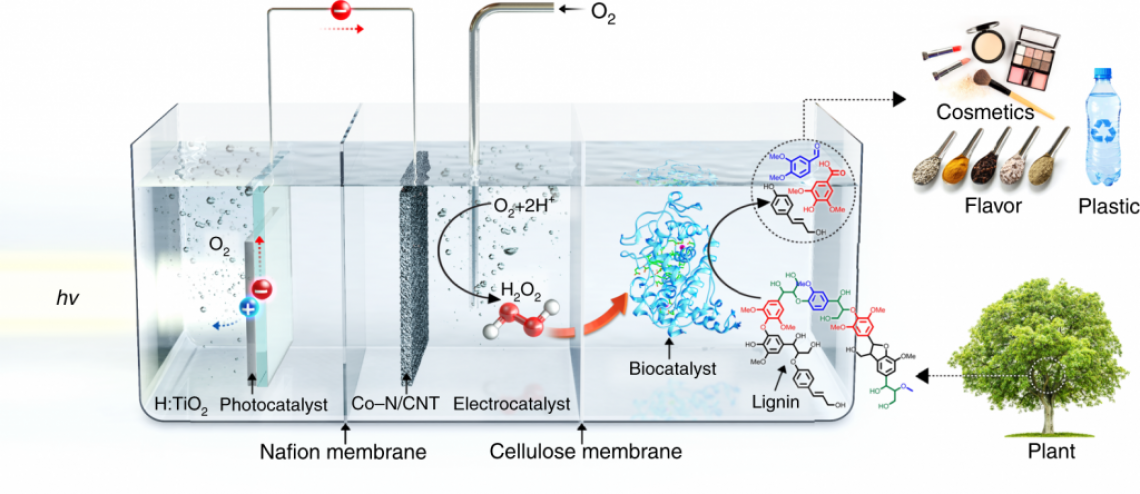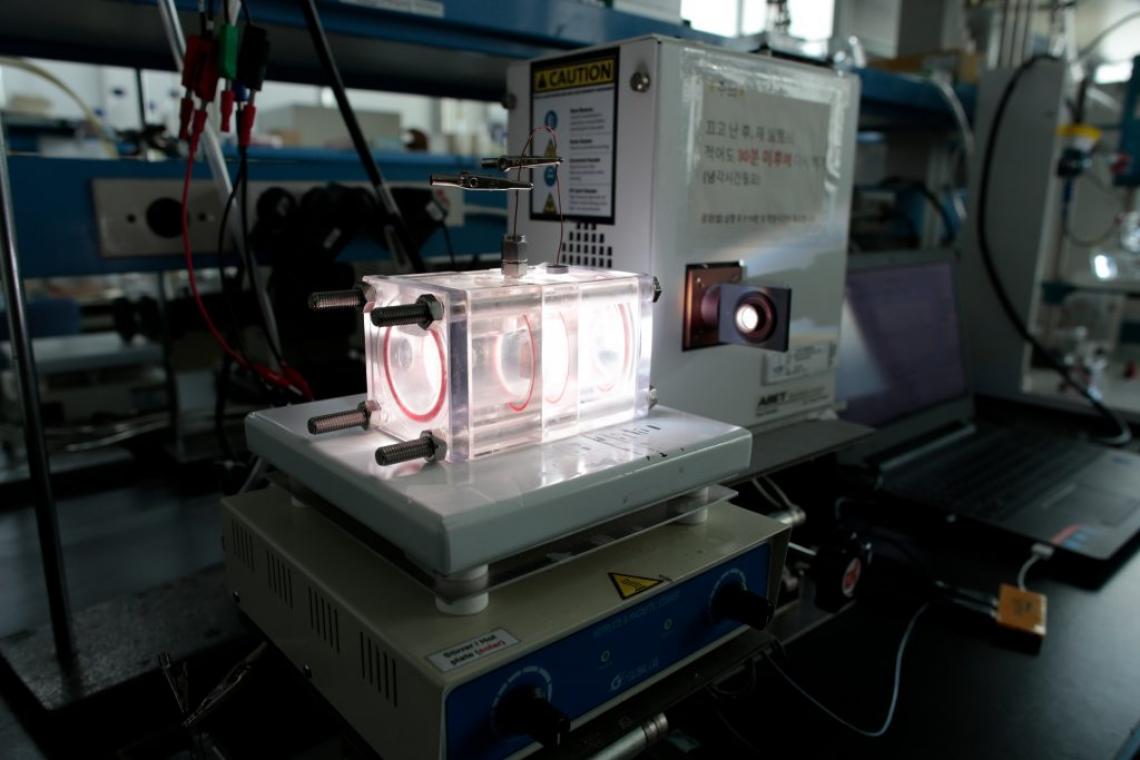Clockwise from top left are Professor Sang Hoon Joo, Professor Yong Hwan Kim, and Professor Ji Wook Jang, and Myohwa Ko in the School of Energy and Chemical Engineering at UNIST.
A research team, jointly led by Professor Ji Wook Jang, Professor Yong Hwan Kim, and Professor Sang Hoon Joo in the School of Energy and Chemical Engineering at UNIST has unveiled a novel biomass conversion technology that can turn forestry biomass residues (i.e., sawdust from timber logging) into higher value fuels and chemicals. Published in the November 2019 issue of Nature Communications, the new technology is expected to reduce our dependency on products made from petrochemicals.
In the study, the joint research team has introduced a fusion catalytic system that can selectively convert lignin, which forms the chief constituent of wood wastes, into higher value chemicals via solar energy.
Schematic illustration of the three-compartment photo-electro-biochemical reactor.
Lignin, after Cellulose, is the second most abundant renewable biopolymer found in nature and is usually discarded as waste in the pulp and paper industry in very large amounts. Unlike Cellulose, the structure of lignin is extremely complex and lacks steric regularity. Such traits make lignin hard to break down and even harder to convert into something valuable. Biocatalysts, such as enzymes, are often involved in lignin degradation, thus careful quantification of the input material (i.e., hydrogen peroxide, H2O2) is important for the activation of catalysts. At present, the process of extracting lignin from biomass is handled via Anthraquinone Process. However, due to high-pressure hydrogen condition and precious metal catalysts, this was not suitable for use with enzymes.
The research team solved this issue via the development of a compartmented photo-electro-biochemical system for unassisted, selective, and stable lignin valorisation. The main advantage of this system is that it involves three catalytic systems (a photocatalyst for photovoltage generation, an electrocatalyst for H2O2 production, and a biocatalyst for lignin valorisation) that are integrated for selective lignin dimer valorisation upon irradiation with sunlight without the need for electrical energy or additional chemicals.
In designing the system, the research team placed polymer electrolyte membranes as seperators between cells to protect the biocatalyst from detrimental conditions generated during the reaction, thus preserved its stability and activity. Their results show that the photo-electro-biochemical system can catalyse lignin dimer cleavage with a 93.7% conversion efficiency and 98.7% selectivity, which far surpasses those of single-compartment (37.3% and 34.8%) and two-compartment (25.0%, 48.1%) systems. The system was further applied for sustainable polymer synthesis using a lignin monomer, coniferyl alcohol, with a 73.3% yield and 98.3% of conversion efficiency; however, the polymer yields of the single-compartment and the two-compartment systems were only ca. 0% and 8.6%, respectively.
Shown above is the photo-electro-biochemical system is composed of three compartments (photocatalyst anode, electrocatalyst cathode, and biocatalyst part).
“This unassisted selective lignin valorisation technology could convert waste lignin to value-added aromatics and polymer without the need for any additional energy and chemicals,” says Professor Ji Wook Jang. “This could possibly overcome the problems associated with current biomass upgradation, such as its low cost effectiveness and limited processing technology.”
“This research is significant as it presents new possibilities for converting biomass such as waste wood into aromatic petrochemicals in an environmentally friendly way,” says Professor Yong Hwan Kim. “We believe that the development and scaling-up of this technology will be a milestone for the replacement of petrochemicals with biochemicals.”
The findings of this research has been published in the prestigious Nature Communications on November 12, 2019. The study has been participated by Myohwa Ko (Combined M.S/Ph.D. of Electrical and Computer Engineering, UNIST), Le Thanh Mai Pham (Postdoctoral researcher, UNIST), and Profesor Young Jin Sa (Department of Chemistry, Kwangwoon University).





